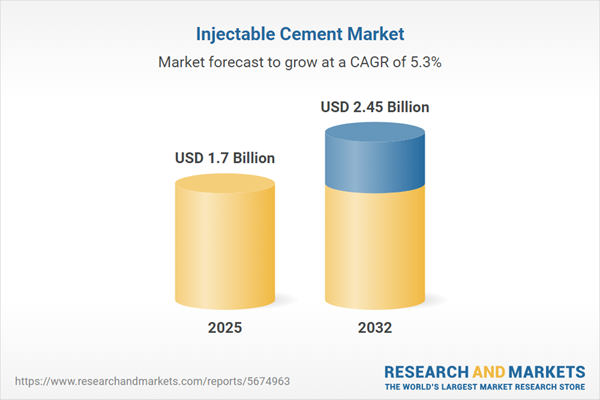Speak directly to the analyst to clarify any post sales queries you may have.
The injectable cement market is becoming an essential area of focus for senior healthcare leaders charged with enabling better outcomes and meeting evolving care standards efficiently. Across orthopedic and trauma applications, injectable cement technologies support streamlined workflows, providing opportunities for improved patient care and organizational flexibility.
Market Snapshot: Injectable Cement Market Size and Growth Dynamics
The global injectable cement market is entering a period of robust expansion, with revenues expected to advance from USD 1.61 billion in 2024 to USD 1.70 billion in 2025, and reaching USD 2.45 billion by 2032. This growth path is underpinned by a compound annual growth rate (CAGR) of 5.33%. A primary driver includes the healthcare industry's pursuit of orthopedic solutions that deliver efficiency and clinical efficacy with reduced procedural complexity. Regulatory advancements and enhanced biocompatibility are reinforcing injectable cement as an integral element in care protocols worldwide.
Scope & Segmentation of the Injectable Cement Industry
- Type: Covers calcium phosphate and PMMA-based formulations, as well as advanced composite materials engineered for specific viscosities and procedural uses in orthopedic care.
- Application: Supports techniques such as kyphoplasty, vertebroplasty, osteoplasty, and bone stabilization after fractures, making injectable cement a versatile choice in both minimally invasive and conventional surgical environments.
- End User: Utilized in hospitals, ambulatory surgical centers, and specialized orthopedic clinics, accommodating differences in case mix, care pathways, and patient volumes across facilities.
- Geography: Demonstrates strong market presence in North and Latin America, significant momentum in Asia-Pacific markets like China, India, and Japan, ongoing expansion in Europe, the Middle East, and Africa, and increasing uptake in Southeast Asia reflecting infrastructure growth.
- Key Companies: Major manufacturers include Medtronic plc, Stryker Corporation, Johnson & Johnson, Zimmer Biomet Holdings, Heraeus Holding, Tecres, MERIL Life Sciences, Biocomposites, BoneSupport AB, and Esschem Pty Ltd, all collaborating closely with regulatory agencies for compliant and innovative product offerings.
- Technologies: Features bioceramic advancements, modern polymer integration, and precise imaging-assisted delivery systems that help optimize surgical outcomes and support higher procedure throughput.
Key Takeaways for Senior Decision-Makers
- Adoption of minimally invasive orthopedic approaches continues to accelerate the role of injectable cement by enabling quicker recovery periods and expanded use across hospital and clinic settings.
- Ongoing material advancements give clinicians a broader toolkit to align product properties with specific patient needs, supporting greater procedural control and patient safety.
- Evolution in surgical delivery platforms is aiding standardization of clinical protocols, which can foster greater consistency and operational efficiency as organizations increase procedure volume.
- Strategic partnership across the supply chain, involving manufacturers, regulators, and practitioners, allows for rapid adaptation to new clinical insights and changing compliance requirements.
- Tailoring organizational strategies enables effective navigation of varying reimbursement structures and compliance landscapes, ensuring business continuity amid ongoing market or regulatory adjustments.
Tariff Impact: Navigating U.S. Trade Policy and Supply Chain Shifts
Shifts in U.S. tariff policy are prompting injectable cement suppliers and hospital systems to reevaluate sourcing approaches. This includes prioritizing nearshoring, strengthening domestic production capabilities, and increasing participation in group purchasing arrangements, all aimed at maintaining supply chain reliability through ongoing trade policy changes.
Methodology & Data Sources
This assessment is developed using peer-reviewed literature, insights from clinical experts and healthcare executives, and detailed analysis of regulatory disclosures, ensuring the intelligence delivered is both actionable and relevant for the strategic priorities of senior leadership.
Why This Injectable Cement Market Report Matters
- Provides leadership teams with up-to-date information essential for adapted planning and responsive operational decisions within the injectable cement market.
- Supports the creation of strategies responsive to differing regulatory and reimbursement requirements across regions and care settings.
- Strengthens organizations’ readiness to address supply chain or policy changes, safeguarding access to advanced technologies and consistent care delivery.
Conclusion
By advancing investment in injectable cement solutions, healthcare organizations can improve patient care standards, strengthen operational flexibility, and confidently adapt to changing clinical, regulatory, and market demands.
Additional Product Information:
- Purchase of this report includes 1 year online access with quarterly updates.
- This report can be updated on request. Please contact our Customer Experience team using the Ask a Question widget on our website.
Table of Contents
3. Executive Summary
4. Market Overview
7. Cumulative Impact of Artificial Intelligence 2025
Companies Mentioned
The companies profiled in this Injectable Cement market report include:- Medtronic plc
- Stryker Corporation
- Johnson & Johnson
- Zimmer Biomet Holdings, Inc.
- Heraeus Holding GmbH
- Tecres S.p.A.
- MERIL Life Sciences Pvt. Ltd.
- Biocomposites Ltd.
- BoneSupport AB
- Esschem Pty Ltd.
Table Information
| Report Attribute | Details |
|---|---|
| No. of Pages | 194 |
| Published | October 2025 |
| Forecast Period | 2025 - 2032 |
| Estimated Market Value ( USD | $ 1.7 Billion |
| Forecasted Market Value ( USD | $ 2.45 Billion |
| Compound Annual Growth Rate | 5.3% |
| Regions Covered | Global |
| No. of Companies Mentioned | 11 |









